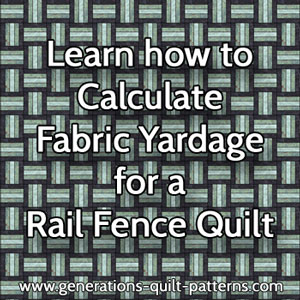- Home
- Quilt Design Inspiration
- Calculate Quilt Yardage
How to Calculate Quilt Yardage
A Triple Irish Chain Checkerboard Pattern - Part 2
This post contains affiliate links, for which I receive compensation.
Learn how to calculate quilt yardage using this Triple Irish Chain quilt pattern variation called 'Checkerboard'.
In the first part of this article, we determined what size the finished quilt needs to be to fit the bed to our needs and decided the size of the smallest patch we are willing to work with.
Now we get down to the nitty-gritty and do the calculations.
The Pattern
This is what our Checkerboard Irish Chain looks like. Black represents the scrappy fabrics; the white represents the background.
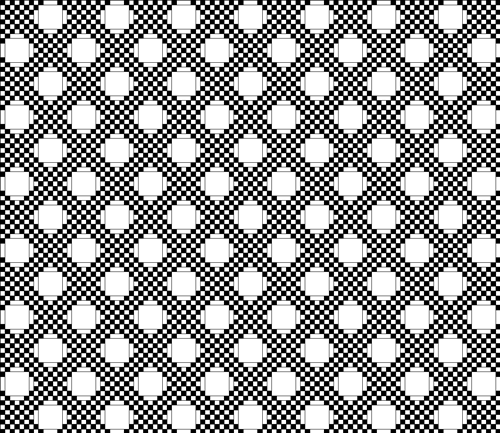
It is made of two blocks: a Checkerboard (l) and an Alternate (r).
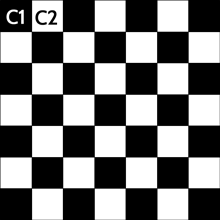 Checkerboard
Checkerboard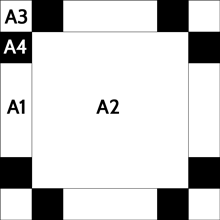 Alternate
AlternateThe six unique patches are labeled. A patch of the same size, in the same block, but from different fabrics (like C1 and C2) is considered unique.
To see an example of this quilt in color click here.
Step-by-Step Chart to Calculate Quilt Yardage
To get the most benefit from the information contained in this chart, I suggest that you open a new window to display Part 1: Calculating Irish Chain Quilt Fabric Yardage.
These calculations are based on a Grid Size of 1" square finished.
Binding, backing and batting calculations are not included.
| Block design | Checkerboard | Alternate | ||||
|---|---|---|---|---|---|---|
| Fabric | Design | Background | Background | Design | ||
| Patch/Name | C1 | C2 | A1 | A2 | A3 | A4 |
| Grid Units/Patch | 1x1 | 1x1 | 1x3 | 5x5 | 1x1 | 1x1 |
| Cutting dimensions/Patch | 1½" x 1½" | 1½" x 1½" | 1½" x 3½" | 5½" x 5½" | 1½" x 1½" | 1½" x 1½" |
| Cut Width of Strip | 1½" | 1½" | 3½" | 5½" | 1½" | 1½" |
| # of patches per block | 25 | 24 | 4 | 1 | 4 | 8 |
| Multiply by number of blocks | 98 | 98 | 97 | 97 | 97 | 97 |
| Total # in quilt | 2450 | 2352 | 388 | 97 | 388 | 776 |
| Usable Width of fabric (inches) | 40 | 40 | 40 | 40 | 40 | 40 |
| Divided by Sub Cut Measurement | 1½" | 1½" | 1½" | 5½" | 1½" | 1½" |
| Patches per strip | 26.67 | 26.67 | 26.67 | 7.27 | 26.67 | 26.67 |
| Round down to whole patches/strip | 26 | 26 | 26 | 7 | 26 | 26 |
| # of patches needed | 2450 | 2352 | 388 | 97 | 388 | 776 |
| Divided by patches/strip | 26 | 26 | 26 | 7 | 26 | 26 |
| Round this up to whole strips | 94.23 | 90.46 | 14.92 | 13.86 | 14.92 | 29.85 |
| # of strips to cut | 95 | 91 | 15 | 14 | 15 | 30 |
| Multiply by cut width of strip | 1½" | 1½" | 3½" | 5½" | 1½" | 1½" |
| Sub-total inches needed | 142½" | 136½" | 52½" | 77 | 22½" | 45 |
| Add your personal 'Fudge Factor' | 11.625" | 11.325" | 6.625" | 9.850" | 3.125" | 4.750" |
| Total Inches needed | 154.13 | 147.83 | 59.13 | 86.85 | 25.63 | 49.75 |
| Divide by 36” to convert to yards | 4.28 | 4.11 | 1.64 | 2.41 | 0.71 | 1.38 |
| Total Yards (rounded up to the nearest ¼ yard) | 4½" | 4¼" | 1¾" | 2½" | ¾" | 1½" |
What if...?
UPDATE: My reader wrote back wondering what would happen if she went to a 2" grid size—that way she'd be able to use precut Jelly Rolls for the scrappy fabric.
That's an excellent question, a great idea and a smart use of her time!
USUALLY the jelly roll strips are 42"-44" long. Remove the selvedge and you should have at least 40" of usable WOF. Since we use WOF to calculate our quilt yardage, double-check the usable WOF just to be sure.
Because I'd put the numbers into a spreadsheet already, it didn't take too much effort to calculate quilt yardage again.
These are the results.
Changes to the block and quilt designs
A 2" grid creates 14" finished blocks.
Remember we want a quilt that measures at least 104"x93". Dividing 14" into both and rounding to full blocks makes for a quilt 8x7 blocks or 112"x98".
So far so good.
56 blocks to make instead of 195—lots less piecing!
The additional drop is pretty evenly distributed; 4" extra on both sides and 5" extra on the bottom or foot of the bed.
Below are diagrams of both quilts, 7" blocks on the left and 14" on the right. These images are displayed to scale so the right one is, and should be, bigger than the left.
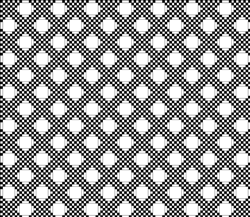 Checkerboard design with 7 inch blocks
Checkerboard design with 7 inch blocks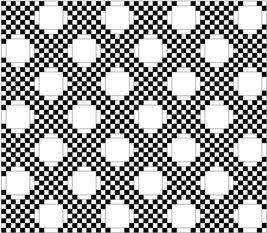 Checkerboard design with 14 inch blocks
Checkerboard design with 14 inch blocksThe only problem is that we've lost the symmetry across the width of the quilt. You, as the designer, get to decide if this is important.
If it is, one solution is to begin and end each row with a half block. Problem solved! Calculate quilt yardage again. It should be pretty close, but you don't want to find yourself an 1" short 18 months after you'd started the quilt!
To calculate quilt yardage with these changes...
I simply plugged the new grid/block sizes into my spreadsheet. (You can open a new window to display the charts next to each other to see where the changes happen.)
This is the resulting chart...
| Block design | Checkerboard | Alternate | ||||
|---|---|---|---|---|---|---|
| Fabric | Design | Background | Background | Design | ||
| Patch/Name | C1 | C2 | A1 | A2 | A3 | A4 |
| Grid Units/Patch | 1x1 | 1x1 | 1x3 | 5x5 | 1x1 | 1x1 |
| Cutting dimensions/Patch | 2½" x 2½" | 2½" x 2½" | 2½" x 6½" | 10½" x 10½" | 2½" x 2½" | 2½" x 2½" |
| Cut Width of Strip | 2½" | 2½" | 6½" | 10½" | 2½" | 2½" |
| # of patches/block | 25 | 24 | 4 | 1 | 4 | 8 |
| Multiply by number of blocks | 28 | 28 | 28 | 28 | 28 | 28 |
| Total # in quilt | 700 | 672 | 112 | 28 | 112 | 224 |
| Usable Width of fabric (inches) | 40 | 40 | 40 | 40 | 40 | 40 |
| Divided by Sub Cut Measurement | 2½" | 2½" | 2½" | 10½" | 2½" | 2½" |
| Patches per strip | 16 | 16 | 16 | 3.81 | 16 | 16 |
| Round down to whole patches per strip | 16 | 16 | 16 | 3 | 16 | 16 |
| # of patches needed | 700 | 672 | 112 | 28 | 112 | 224 |
| Divided by patches per strip | 16 | 16 | 16 | 3 | 16 | 16 |
| Round this up to whole strips | 43.75 | 42 | 7 | 9.33 | 7 | 14 |
| # of strips to cut | 44 | 42 | 7 | 10 | 7 | 14 |
| Multiply by cut width of strip | 2½" | 2½" | 2½" | 10½" | 2½" | 2½" |
| Sub-total inches needed | 110 | 105 | 17.5 | 105 | 17.5 | 35 |
| Add your personal 'Fudge Factor' | 9.5 | 9.25 | 7.63 | 16.25 | 3.63 | 4.75 |
| Total Inches needed | 119.5 | 114.25 | 25.13 | 121.25 | 21.13 | 39.75 |
| Divide by 36” to convert to yards | 3.32 | 3.17 | 0.70 | 3.37 | 0.59 | 1.10 |
| Total Yards (rounded up to the nearest ¼ yard) | 3½" | 3¼" | ¾" | 3½" | ¾" | 1¼" |
You'll now need a total of 8.25 yards of background and 58 2-1/2" strips (with a 40" usable width of fabric) of the design fabric to make this quilt. Backing, batting and binding are again NOT included in these calculations.
There's always a trade-off...
If you compare the charts, you'll see that for this second alternative you need 1 less yard of background. Cool beans!
And there's a lot less piecing—195blocks vs 56blocks! Even COOLER BEANS!
BUT...
...and you knew there was a but, right???!
The open square in the alternate block is four times as big now, 5"x5" vs 10"x10". Plus the A1 pieces make it even bigger. If you're happy free motion quilting or plan to send this out to have it quilted, then there's no issue. But it is a trade-off, piecing time for quilting time.
And again, only YOU, as the DESIGNER, can make that decision as to how you want to spend YOUR time and money.
A simpler example...
That was a lot of numbers to digest.
Is your head spinning?
Don't give up.
Just take a step back to an easier example.
One block. One patch.
For less distraction visit Calculate Quilt Yardage for a Rail Fence quilt.
